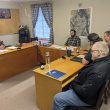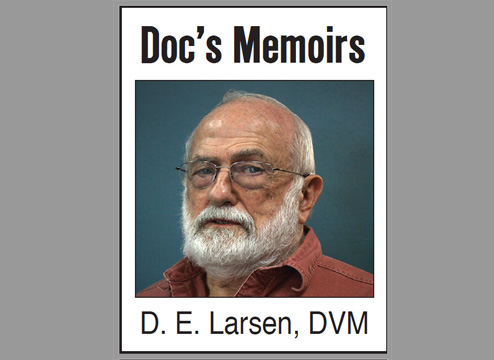By D.E. Larsen, DVM
I turned off of McDowell Creek Road into the barnyard. I could see only a few cows in the holding pen and a couple of guys heading up the hill to the upper pasture. I looked at the clock to make sure I wasn’t early for the herd’s fall pregnancy exams.
Bill came out of the barn to greet me.
“I’m sorry, Doc,” Bill says. “The boys are having a heck of a time getting the cows down. They smell a rat, I guess.”
“We could reschedule for another day,” I said. “I figured this will take the better part of the morning, and I have some afternoon work to do.”
“I think they will get the rest of them on this trip up the hill,” Bill said. “Maybe we could take you over to look through one of the chicken houses, if that would interest you.”
“I have a lunch planned for everyone when the work is done,” Mary Jane said. “That should get you back to the office on schedule.”
“OK, you twisted my arm just hard enough,” I said. “And yes, I would love to look through one of your chicken houses.”
“We don’t allow many people into these houses,” Bill explained. “It is upsetting to the birds when a stranger shows up. We try to have the same worker to handle each house. That way, there is no upheaval. We will be okay today if we just step through the door and stand and look.”
We stepped inside. This was a sizable open chicken house, constructed of steel. It reminded me of the Quonset huts on the Army bases in Korea. These were about 30 feet wide and more than 100 feet long. It was all open area on the inside except for a small room for feed and supply storage. The chickens ran free. And there must have been 1,000 birds in this house.
“The company owns the birds,” Bill said. “They supply everything, the feed and the medical care. We just supply the house and labor. We get paid when they go to the market. It is to our benefit to have rapid growth and good survival. But if these birds grow too fast, they have heart problems, their hearts sort-of explode – sort of a heart attack, I guess.”
“Chicken medicine is a real specialty in veterinary medicine,” I said. “You just about have to go to vet school in Georgia to get any real education in chicken medicine. Just like swine medicine, you have to go to Missouri or Kansas to get much in the way of swine medicine.”
“If we have any losses, the veterinarian comes by and autopsies a few birds and gives us the answer and directions on what to do,” Bill said.
“Yes, chicken medicine is population medicine,” I said. “I had a virology professor who went to vet school in Georgia. He told a story of his diagnostic lab rotation during his senior year. A group of four students would spend a couple of weeks running the diagnostic lab. People would bring in several birds and fill out a questionnaire, then the students would euthanize the birds and do a necropsy. That way, they could come up with a flock diagnosis. ‘Necropsy’ is the veterinary term for autopsy.
“His group came up with a plan to finish the work faster so they could have time for a morning cup of coffee. One guy would check in the birds, pass them to the back, and then fill out the paperwork. So, by the time the paperwork was done, the birds were euthanized, and the necropsies were complete.
“This one day a lady brings in a big rooster. The guy up front passes the rooster to the back, and the group starts the process back there. The guy up front goes through the paperwork. ‘What signs of disease do you see in your birds?’ he asks.
“‘He has diarrhea,’ the lady replies.
“Noticing this comment, he asks, ‘How many birds are in your flock?’
“‘One,’ says the lady.”
“Oops,” Bill said.
“Let’s go see if they are ready to get to work on the cows,” Mary Jane said.
With the cows lined up in the crowding alley and a crew of several young guys pushing the cows, the pregnancy exams go fast. The pregnancies were sort of spread out more than I liked. They ran from 40 days to five or six months of pregnancy.
The good thing was that almost all the cows were pregnant. Only one was open.
The spread was something I’d need to talk with Bill about. He was going to be delivering calves for more than four months instead of the month and a half I preferred. But getting there was a multi-year project that required increasing his replacement heifer numbers and doing some selective culling. That discussion would need a couple of sitdown sessions.
The best part of the day was lunch. When the herd was done, we all went to the house. I spent the most time at the sink and was able to get myself mostly clean. Only a small manure stain on my shirt’s left shoulder remained. Had I known lunch was on the schedule, I would have brought another shirt.
Mary Jane set a table that reminded me of the lunches during silo-filling when I was young. They more resembled Thanksgiving dinner. We had roast beef, potatoes and gravy, veggies and a salad. And then, to top it off, apple pie with a scoop of ice cream.
We had plenty of time to talk following lunch. I told a bit about my early days of growing up in Coos County and how many farms were in the little valleys.
“When I was a kid here, the school bus was always full,” Bill said. “There were family farms on the road all the way to town. Those are all gone today.”
“It is interesting,” I said. “I have been transcribing the journals of my great-grandfather and great-uncle. My great-grandfather talks about selling a bull for 11 cents a pound in 1890. And my great-uncle sold a bunch of steers for 54 cents a pound in 1952. It just seems like those were pretty good prices for those days. Today, a young person can’t buy a ranch and make a go of it.”
“I think it is pretty sad,” Bill said. “The loss of the family farm has been a major change in society today.”
When the talk was over, I gathered my things, thanked Mary Jane for the super lunch and headed back to the office to finish my day.
***
The following morning I noticed Bill standing at the front counter. He looked a little agitated as he was waiting for his turn to talk with Sandy. I went out and shook his hand.
“Doc, I have got to show you this,” Bill said. “I have been up most of the night after we discussed your great-uncle’s journals.”
We moved into an exam room, and Bill laid out a crumpled piece of paper he’d been using for a scratchpad.
“If your great-grandfather sold a bull for 11 cents a pound in 1890,” Bill started, his hand shaking as he pointed to the paper, “the closest figure I could find was a Model T in 1908. It cost $850. Figuring 1,100 pounds for a bull approaching two years of age, he would have needed seven of those bulls to buy that car.”
“That’s interesting,” I said.
“Oh, there is more here,” Bill continued. “In 1952, my father went down to Lebanon and bought the best top-of-the-line Buick that they had on the lot. He paid $3,200 for that car. If your great-uncle was selling steers for 54 cents a pound in 1952, figuring those steers were 500 pounds, he would have had to have 12 of those steers to buy that car.”
“I am betting that you are trying to say things have changed a little,” I said.
“Changed a whole lot, I would say,” Bill said. “I could sell every darn animal I have out there, and I wouldn’t come close to being able to buy a decent car.”
“Those are interesting figures,” he said. “They show the status of the farmer in the country today. When I was in dairy practice in Enumclaw, I was told that the guy who delivered milk to the store got more out of that gallon of milk than the dairy farmer.”
“It is no wonder that a guy can’t make a living ranching today,” Bill said.
– David Larsen is a retired veterinarian who practiced 40 years in Sweet Home. More of his stories are available on his blog at docsmemoirs.com.





